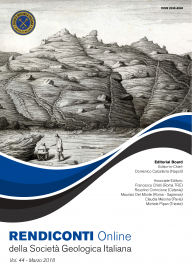Abstract
Since XVIII century, Rome and its metropolitan area represented a natural laboratory for the development of geological studies in urbanized areas. The peculiar geological framework of the Eternal City and of the surrounding municipalities depends on the tectono-sedimentary evolution of the Tyrrhenian margin of Central Apennines, strongly affected by volcanism during Quaternary. Moreover, three millenniums of human activity induced permanent "bioturbation" of the natural environment in the Roman area, thus creating a unique scenario attracting the interest of naturalists, geologists and archaeologists in the last three centuries. Systematic studies of the town territory and of its underground have been progressively carried out over time, both for technical and scientific purposes, aimed to describe Rome's geological setting and thus to provide a useful tool for sustainable landuse planning and management and for urban development.
Starting from early works on karst caves performed by geologists, speleology increasingly developed in Rome, since the institution of the first organized group in 1904. Along this path, an overlapping between geological research and speleological exploration often occurred especially after WW2, being the members of the group mostly recruited among University students. It was the age of "geological renaissance" in Italy; youth was encouraged to Earth sciences studies because of possible career opportunities in hydrocarbon research field.
At the same time local administrations, firstly the Province of Rome, started to consider mapping of underground cavities network essential for land management and planning. In these terms, attention for anthropogenic cavities and for previous archaeological and historical studies on Rome catacombs and underground quarries renewed, being the issue of sudden collapses in urban and suburban areas detected as a serious hazard. For these reasons, local institutions supported and promoted systematic studies on the underground of Rome and of its province.
In such a context, Ugo Ventriglia was surely the pioneer of this approach to urban geology in Rome's natural laboratory. On the other hand, Renato Funiciello, working on the same topic with different
methods, paid as well attention to underground voids in the studies about Rome he coordinated through years. Consequently, Ugo and Renato, in their "geological race for the Seven Hills" during the last three decades of the XX century, metaphorically crossed each other also in the underground of Rome. The scientific competition led both scientists, following different approaches and independent paths, to improve the geological knowledge of the Eternal City, leaving a precious legacy to present and future generations and guiding subsequent studies. Nowadays land planning and management of Rome metropolitan area lay thus on this solid foundation.
Keywords
Get Full Text
